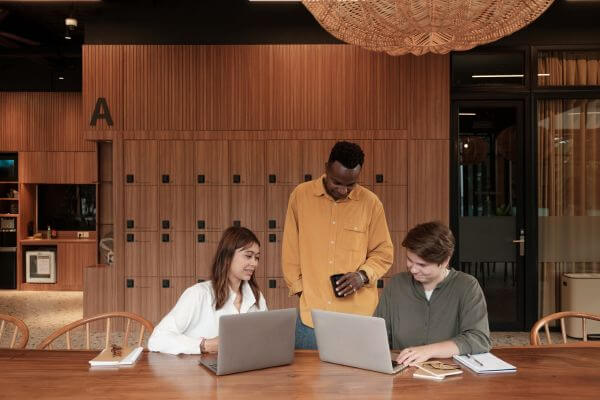In an era where remote work and flexible schedules have become the new norm, creating a productive work environment has never been more important. Whether you’re working from a traditional office space or the comfort of your home, the design of your workspace plays a crucial role in your overall productivity and well-being. This comprehensive guide delves into the art of designing a workspace that fosters peak productivity, offering valuable insights and practical tips to help you optimize your work environment.
Introduction
The concept of productivity is not limited to simply getting more work done in less time; it encompasses the efficient allocation of your resources, effective time management, and maintaining a work-life balance. A well-designed work environment can significantly influence these aspects, allowing you to perform at your best.
The Importance of a Productive Work Environment
A productive work environment can have a profound impact on your professional and personal life. Here are some of the key benefits:
- Increased Efficiency: An optimized workspace reduces distractions and interruptions, enabling you to focus on tasks more effectively.
- Enhanced Creativity: The right environment can stimulate creativity and innovation, leading to better problem-solving and idea generation.
- Better Health and Well-being: A well-designed workspace can improve your physical and mental health, reducing stress and promoting overall well-being.
- Improved Work-Life Balance: When your workspace is conducive to productivity, you can accomplish tasks more efficiently, freeing up time for leisure and relaxation.
Now, let’s explore how you can elevate your work environment to achieve these benefits.
Choosing the Right Location
Home Office vs. Traditional Office
The first decision you need to make when designing your workspace is choosing between a home office and a traditional office. Each has its advantages and considerations.
Home Office:
- Flexibility: You have more control over your environment and can tailor it to your preferences.
- Cost Savings: No need to commute or pay for office space.
- Comfort: You can create a comfortable, personalized space.
Traditional Office:
- Separation of Work and Home: A dedicated office space can help you mentally separate work from personal life.
- Collaboration: Easier access to colleagues for collaboration and networking.
- Professional Environment: Meetings with clients or partners may be more appropriate in a traditional office.
Consider your work style, job requirements, and personal preferences when making this decision.
Home Office: Crafting Your Perfect Workspace
If you opt for a home office, it’s essential to create an environment that promotes productivity and minimizes distractions.
- Dedicated Space: Designate a specific area in your home exclusively for work. Avoid working in your bedroom or other leisure spaces.
- Comfortable Furniture: Invest in ergonomic furniture, including a comfortable chair and an adjustable desk to support your posture and well-being.
- Natural Light: Position your workspace near a window to maximize natural light, which can boost mood and productivity.
- Personal Touch: Add personal touches, such as artwork or plants, to make the space your own while maintaining professionalism.
Ergonomics: The Foundation of Productivity
Ergonomics focuses on designing your workspace to optimize comfort and efficiency. Neglecting ergonomic principles can lead to health issues, decreased productivity, and discomfort.
Key Ergonomic Considerations:
- Chair and Desk: Invest in an ergonomic chair and adjustable desk to support good posture and reduce strain on your back, neck, and wrists.
- Monitor Placement: Position your monitor at eye level to reduce neck strain and minimize glare.
- Keyboard and Mouse: Choose ergonomic keyboards and mice to prevent wrist and hand discomfort.
- Lighting: Ensure adequate, adjustable lighting to reduce eye strain and create a well-lit workspace.
- Cable Management: Keep cables organized to prevent tripping hazards and maintain a clutter-free environment.
Ergonomic Tools for a Healthier Work Environment
To fine-tune your workspace for ergonomic comfort, consider these tools:
- Ergonomic Mousepad: Provides wrist support and reduces strain during extended computer use.
- Footrest: Helps maintain proper posture by supporting your feet at a comfortable height.
- Standing Desk Converter: Allows you to switch between sitting and standing to reduce the negative effects of prolonged sitting.
- Ergonomic Accessories: Explore accessories like laptop stands and monitor arms for additional customization.
Minimizing Distractions
Distractions are productivity killers, and designing your workspace to minimize them is essential.
Tips for Minimizing Distractions:
- Declutter: Keep your workspace tidy by removing unnecessary items.
- Noise Control: Use noise-cancelling headphones or white noise machines to block out unwanted sounds.
- Privacy: If possible, create a dedicated space with a door to reduce interruptions.
- Digital Distractions: Use website blockers and apps to limit access to distracting websites and apps during work hours.
Creating a Distraction-Free Zone
To conquer distractions effectively, take these steps:
- Establish Boundaries: Communicate with family members or roommates about your work hours to minimize interruptions.
- Schedule Breaks: Plan short, scheduled breaks to address non-work-related activities.
- Use Focus Techniques: Incorporate techniques like the Pomodoro method to work in focused bursts with built-in breaks.
Personalization and Inspiration
A workspace that reflects your personality and inspires you can boost motivation and creativity.
Personalization Ideas:
- Color Psychology: Choose colors that promote focus and creativity. Blue and green are known for their calming effects, while red can stimulate energy and alertness.
- Art and Decor: Display artwork, motivational quotes, or photos that resonate with you and ignite your passion.
- Plants: Incorporate indoor plants to improve air quality and add a touch of nature to your workspace.
- Organizational Systems: Invest in storage solutions that not only keep your workspace organized but also look aesthetically pleasing.
Creating an Inspiring Workspace
To infuse inspiration into your workspace, follow these strategies:
- Vision Board: Create a vision board with your goals and aspirations to stay motivated.
- Inspirational Quotes: Frame and display quotes that inspire and remind you of your purpose.
- Personalized Desk Setup: Arrange your workspace to showcase your unique interests and values.
- Flexible Layout: Keep your workspace adaptable to accommodate changes and maintain a fresh, inspiring atmosphere.
Technology and Connectivity
Efficient technology and connectivity are paramount in today’s work environment. Ensure that your workspace is equipped with the right tools to support your work.
Technology Essentials:
- High-speed Internet: A stable and fast internet connection is crucial for remote work and online collaboration.
- Reliable Hardware: Invest in a reliable computer, smartphone, and other necessary gadgets.
- Backup Solutions: Implement data backup and recovery solutions to protect your work.
- Productivity Software: Use project management, task scheduling, and communication tools to streamline your work.
Tech Tips for a Connected Workspace
Stay connected and productive with these tech-savvy suggestions:
- Wireless Charging: Simplify charging with wireless chargers for your devices.
- Second Monitor: Enhance multitasking by adding a second monitor for increased screen real estate.
- Cloud Storage: Use cloud storage solutions for easy access to files from any device.
- Digital Security: Invest in cybersecurity measures to protect your data and privacy.
A Balanced Work-Life Integration
Creating a productive work environment also involves setting boundaries and maintaining a healthy work-life balance.
Strategies for Balance:
- Set Boundaries: Establish clear work hours and stick to them. Avoid overworking.
- Take Breaks: Schedule regular breaks to recharge and avoid burnout.
- Separate Work and Personal Spaces: If working from home, physically separate your work area from your living space.
- Exercise and Healthy Habits: Incorporate physical activity and healthy routines into your daily schedule.
Achieving Work-Life Harmony
To maintain a balanced work-life integration, consider these practices:
- Digital Detox: Allocate device-free time to disconnect from work-related notifications.
- Mindfulness and Meditation: Practice mindfulness to reduce stress and improve focus.
- Social Interaction: Make time for social connections, whether in person or virtually, to combat isolation.
- Routine Reflection: Regularly assess and adjust your work-life balance to ensure it aligns with your goals and values.
Conclusion
Designing a workspace for peak productivity is not a one-size-fits-all endeavor. It’s a personalized journey that requires thoughtful consideration of your needs, preferences, and job requirements. By focusing on ergonomic principles, minimizing distractions, infusing inspiration, and embracing technology, you can create a work environment that not only enhances your productivity but also contributes to your overall well-being.
Remember, the goal of a productive workspace is not just to work harder but to work smarter and live better. Take the time to evaluate your current workspace and make the necessary changes to unlock your full potential and elevate your work environment to new heights of productivity and satisfaction. Your workspace should be a reflection of your aspirations and a catalyst for your success in an ever-evolving work landscape.



